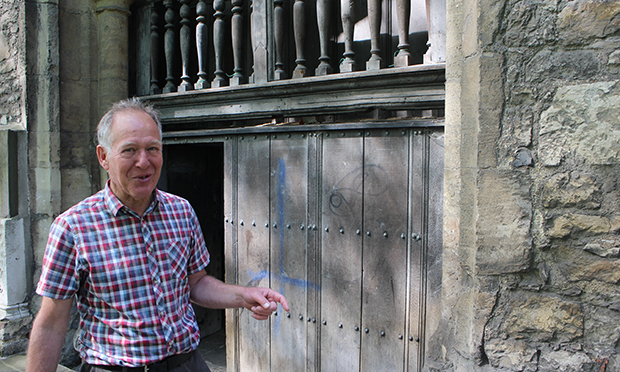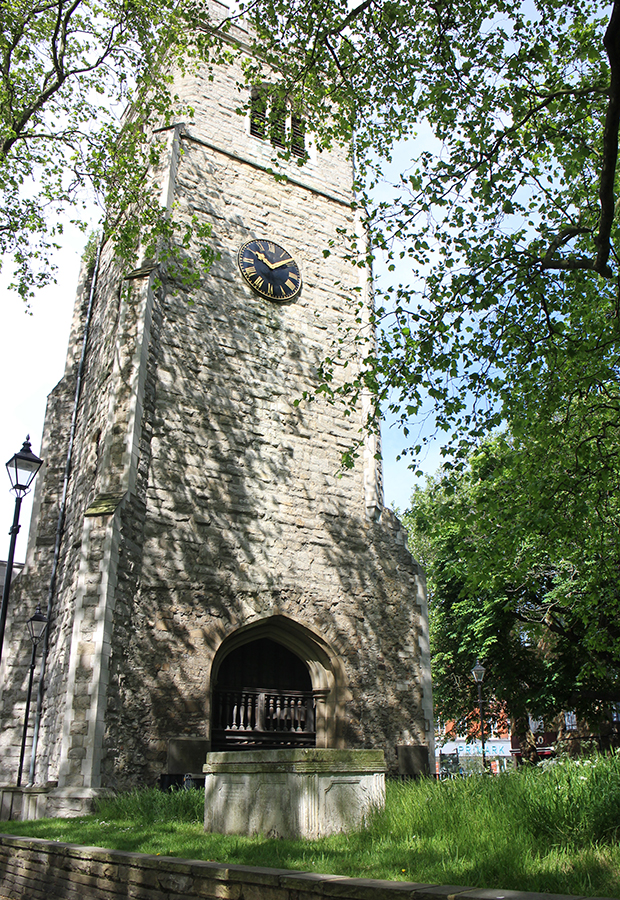St Augustine’s Tower: ‘it was Buckingham Palace for pigeons’

Keeper of the tower: Laurie Elks. Photograph: Jordan Milne
From a medieval church and a Georgian bell tower to a Victorian tool shed and a Buckingham Palace for pigeons, the past of Hackney’s oldest building is etched on its 740-year-old walls.
Built around 1275, St Augustine’s Tower is the last standing remnant of Hackney’s medieval church and has since become a symbol of the borough, represented on the London Borough of Hackney’s coat of arms.
Tudor times
“The medieval church was rebuilt in 1520 by a man called Christopher Urswick, a courtier of Henry VII and rector at the time,” says Laurie Elks, a Trustee of the Hackney Historic Buildings Trust and now the tower’s keeper.
Throughout the Tudor period many notable members of the King’s court used the church, including Thomas Cromwell. And in 1667 diarist Samuel Pepys paid a visit and remarked on the church’s fine organ, though, in his words, he went “chiefly to see the young ladies”.
New church
Yet with Hackney’s growing population, which soared to over 12,000 people by the end of the 18th century, the church soon became unfit for purpose.
Pointing towards the stumps of stone – corner stones of the church – hidden by the sea of bluebells and cow parsley that now stretch before the tower, Mr Elks explains: “The church stood here until 1798 when it was no longer big enough for Hackney’s population, it could only hold 800 people and so it was decided a new church had to be built.
“The parish raised £10,000 to build the new St John at Hackney, which you can see and hear from here. And although that was a lot of money there was not enough to build another bell tower.
“So the Georgians, who didn’t rate Gothic buildings, knocked down the church but kept the tower to house the eight bells, and here they stayed until 1854. Fortunately by then the Victorians liked Gothic buildings and so it survived.”
Wilderness years
But by the end of the 19th century the building was functionally redundant.
In the years that followed the tower was used as a mortuary and then, once the graveyard had been cleared in the 1890s to make way for a public garden, it became the gardener’s tool shed.
But the tombstones that now line the public garden show that before its clearance, the graveyard was the final resting place of the great and the good of Hackney alike.
Sean Gubbins of the Hackney Society said: “Buried in the churchyard was the great grandfather of Baden Powell, the founder of the Scout movement; Admiral Beaufort, after whom the Beaufort Wind Scale is named, and Edward de Vere, Earl of Oxford, who some think was the real Shakespeare.
“There is also a nearby plaque to Fred Peters, a blind man who sat on the same spot selling matches for 30 years.”
Maintenance of the tower and its gardens fell to the Metropolitan Borough of Hackney in 1912 and by the 1980s, Mr Elks explained: “It had become lost in the general state of chaos that was happening in the borough at the time.
“The council stopped winding the clock and just locked the door. And so it became a Buckingham Palace for pigeons.”
New regime
Finally in 1990 the Hackney Historic Buildings Trust became responsible for the tower. “And since then we have done 100 small things to make the tower more safe for visitors,” says Mr Elks.
Climbing 135 worn steps up a narrow winding staircase leads visitors to the roof of the three storey tower, from which they can see all the way to Epping Forest, Alexandra Palace and beyond.

St Augustine’s Tower was built around 1275. Photograph: Jordan Milne
